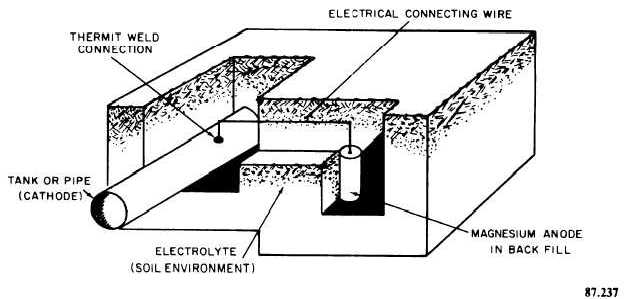galvanic cathodic protection is shown in figure 7-14.
Impressed Current Method
The impressed current method of cathodic protection is designed to protect large metal structures located in corrosive areas. With this method of protection a source of alternating current is required. Also, a rectifier is needed to obtain the required direct current potential.
The basic principle of the impressed current method is merely the application of the galvanic cell reaction. The component parts of this method are the cathode (the metal structure to be protected), the anode (made of suitable anodic material), the electrolyte or ground (the ionized corrosive material), and the rectifier and various connections that serve to complete the electrical circuit. The operation of this method depends on the rectifier forcing direct current from the anode through the electrolyte (ground) to the metal structure to be protected. This method causes the metal structure to be the cathode, suppresses the anodic currents from it, and, in turn, prevents corrosion of the structure. An impressed current method of cathodic protection is shown in figure 7-15.
FIELD TEST EQUIPMENT FOR CATHODIC PROTECTION
The items of field test equipment that the UT uses to make tests when installing, operating, and maintaining cathodic protection systems are the volt-millivoltmeter, multicombination meter, resistivity instrument, buried pipe locator, and the protective coating leak detector. This equipment is discussed in the following paragraphs.
Volt-Millivoltmeter
In corrosion and cathodic protection testing in the field, it is necessary to measure the potential of the structure being investigated as compared to the earth along the structure and to other metallic structures. It is also necessary to measure the potential of rectifiers, batteries, galvanic anodes, and sometime potentials along the earth’s surface to determine the distance being protected. The potentials may vary from millivolts to 20 volts or more. Various types of voltmeters are used for this purpose. One of these instruments is the volt- millivoltmeter. It is a recording instrument designed with a chart that makes one revolution in 24 hours. The instrument will record the variations in potential and reveal the electrolytic conditions around a structure.
Multicombination Meter
The multicombination meter is used quite often in cathodic protection work. It is designed as a combination unit and actually consists of more than one instrument. The meter can be used as a high-resistance voltmeter, an ammeter, a

Figure 7-14. - Galvanic cathodic protection.
Continue Reading